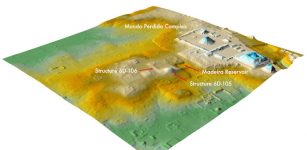Mysterious 7,000-Year-Old Circular Structure Near Prague Investigated By Scientists
Jan Bartek - AncientPages.com - Archaeologists are investigating a puzzling 7,000-year.old circular structure discovered in Vinoř, an area on the outskirts of Prague, Czech Republic.
The purpose of the ancient Neolithic structures is still unclear, but scientists hope further studies will shed more light on why the monumental buildings were constructed and who and by whom they were used. Despite being older than the Egyptian pyramids or England’s Stonehenge, these intriguing ancient structures are still extremely well-preserved.
Few people know about Central Europe’s ‘roundels’, but these Neolithic circular enclosures have secrets to reveal.
“The so-called roundels are the oldest evidence of architecture in the whole of Europe. They are a series of circular ditches and they are always arranged in a circle with two, three, four or more entrances to the center, four being the most common. The circular ditches usually number between one and three, or very rarely four. The whole structure reaches an average of between 30 to 240 meters, but you most commonly find them in the range of 60 - 80 meters. Perhaps I should emphasize that these ditches are usually around one and a half meters wide, but we know of ditches up to fourteen meters wide and six meters deep,” Jaroslav Rídký from the Institute of Archaeology of the Czech Academy of Sciences in Prague told Radio Prague International.
You can visit to-scale replicas of roundels in Goseck, Germany and Heldenberg, Austria, but there are currently no life-size models in the Czech Republic, which Řídký thinks is a shame. At present, around 200 roundels have been discovered, of which about 55 are in the Czech Republic. At least two are particularly worth mentioning.
"A total of three roundels were found during the construction of the Kolín bypass, and one of them was the absolute largest in all of Central Europe - we call it a megarondel. Just shy of 240 meters in diameter, it had three completed trenches - the fourth was not completed, but if it had been, it would have made it to 240 meters - and four preserved entrances to the center. And interestingly, about fifty meters away, another roundel was built at around the same time, but this time with only one ditch. So that is one example.
And then I would definitely mention the roundel in Trebovetice, in the Jicín district, which is preserved in the forest and was confirmed relatively recently. It was discovered thanks to these ramparts, the existence of which has been a hot topic of discussion among experts in the last thirty to forty years – indeed, discussion about whether they even existed or not. So now we know that they did exist, and those ramparts are still visible today. They are right in the middle of the woods, you can walk there and they are quite obvious," Rídký said.
The current investigation of a roundel in Prague’s district of Vinoř can provide scientists with more information about the structures' purpose.
Despite these findings, it is still unclear what purpose these structures have served, says Miroslav Kraus, who is in charge of the research.
“One of such theory is that it could have been used as an economic center, a center of trade. It could also have been a centre of some religious cult, where rites of passage or rituals connected to the time of year were performed.
“Roundels were built during the Stone Age, when people had not yet discovered iron. The only tools they could use were made of stone and animal bones,” Kraus told Radio Prague International
"The roundel in Vinoř, which measures 55 meters in diameter, has an unusual floor plan with three separate entrances.
What makes its research unique is that archaeologists have uncovered the structure almost in its entirety, says Mr. Kraus:
“We have the opportunity to uncover nearly the whole structure, or rather what remained of it. At the same time I should note that part of the structure was revealed back in the 1980s, during the laying of gas and water pipelines,” Kraus said.
Artist's impression of what the Neolithic structure may have looked like. Credit: Institute of Archaeology of the Czech Academy of Sciences
Scientists will now take samples for analysis and the results should provide researchers with more information about the original structure.
“It would be great to discover something that would indicate the actual function of the building. However, it is very unlikely, since none of the previously researched roundels had revealed such information.
“It would also be great to find something that would suggest its real age. So far, radiocarbon dating of samples collected from roundels has put their age somewhere between 4900 years to 4600 BC. That is a pretty wide time span,” Kraus added.
See also: More Archaeology News
It should be added that over 200 of these circular Neolithic structures have been discovered in most parts of Central Europe, including Germany, Poland, Slovakia, Hungary, Austria, and, of course, the Czech Republic. Obviously, these circular neolithic structures must have been important to our ancestors, and the purpose of the monuments will hopefully be understood soon.
Written by Jan Bartek - AncientPages.com Staff Writer























